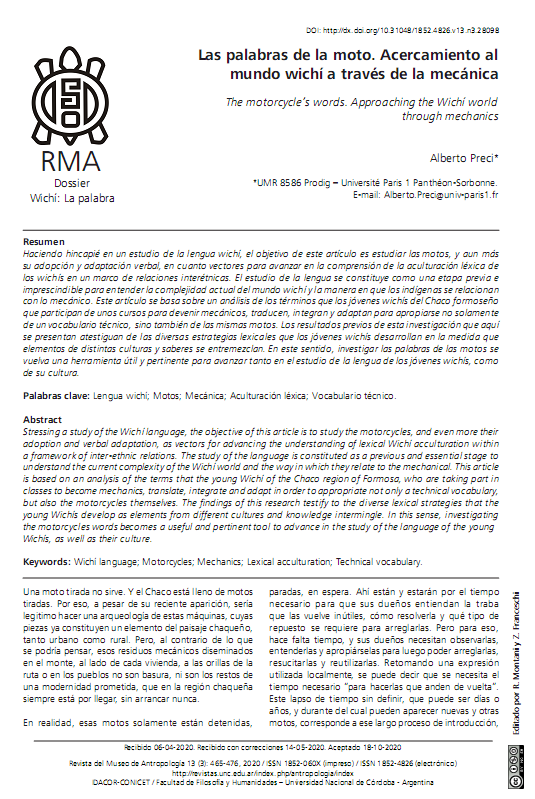The motorcycle’s words. Approaching the Wichí world through mechanics
DOI:
https://doi.org/10.31048/1852.4826.v13.n3.28098Keywords:
Wichí language, motorcycles, mechanics, lexical acculturation, technical vocabularyAbstract
Stressing a study of the Wichí language, the objective of this article is to study the motorcycles, and even more their adoption and verbal adaptation, as vectors for advancing the understanding of lexical Wichí acculturation within a framework of inter-ethnic relations. The study of the language is constituted as a previous and essential stage to understand the current complexity of the Wichí world and the way in which they relate to the mechanical. This article is based on an analysis of the terms that the young Wichí of the Chaco region of Formosa, who are taking part in classes to become mechanics, translate, integrate and adapt in order to appropriate not only a technical vocabulary, but also the motorcycles themselves. The findings of this research testify to the diverse lexical strategies that the young Wichís develop as elements from different cultures and knowledge intermingle. In this sense, investigating the motorcycles words becomes a useful and pertinent tool to advance in the study of the language of the young Wichís, as well as their culture.
Downloads
References
Alvarsson, J-Å. (1988). The Mataco of the Gran Chaco: An Ethnographic Account of Change and Continuity in Mataco Socio-Economic organization. Uppsala: Acta Universitatis Upsaliensis vol. 11.
Basso, K.H. (1967). Semantic aspects of linguistic acculturation. American anthropologist, 69(5), 471-477.
Bernstein, B. (1964). Elaborated and Restricted codes: their social origins and some consequences. American Anthropologist, 66(6), 55-69.
Braunstein, J. (2006). El signo del agua: Formas de clasificación étnica wichí. En I. Combès (Ed.), Definiciones étnicas, organización social y estrategias políticas en el Chaco y la Chiquitania (pp. 145-156). Santa Cruz: IFEA, SNv & El País.
Brown, C.H. (1994). Lexical Acculturation in Native American Language, Currrent Anthropology, 35(2), 95-117.
Brown, C.H. (1999). Lexical acculturation in native American languages. New York: Oxford University Press.
Brown, C.H. y Witkowski, S.R. (1981). Figurative Language in a Universalist Perspective. American Ethnologist, 8(3), 596-615.
Brown, C.H. y Witkowski, S.R. (1983). Polysemy, Lexical Change and Cultural Importance, Man, 18(1), 72-89.
Censabella, M. (1999). Las lenguas indígenas en la Argentina. Buenos Aires: EUDEBA.
Córdoba L., Bossert F. y Richard N. (Eds.). (2015). Capitalismo en las selvas: Enclaves industriales en el Chaco y Amazoníaindígenas (1850-1950). San Pedro de Atacama: Ediciones del Desierto.
Dorais, L-J. (1970). L’acculturation lexicale chez les esquimaux du Labrador. Langages, 18, 65-77.
García, S.S. (2016). Aculturación léxica en El Gran Nayar: presencia del cora en el español del siglo XVIII. Temas Antropológicos. Revista Científica de Investigaciones Regionales, 38(2), 19-44.
García, S.S. y García Molina, A. (2016). Estrategias de aculturación léxica del náayeri o cora: un estudio de disponibilidad léxica. Boletín de Lingüística, 45-46, 134-152.
Gomes, A.M.R. (2017 [1998]). “Vegna che ta fago scriver”. Etnografia della scolarizzazione in una comunità di Sinti. Roma: CISU.
Grosjean, F. (1982). Life with Two Languages: An Introduction to Bilingualism. Cambridge: Harvard University Press.
Krohn, H.S. (2016). Aculturacion lexica en bribri. Estudios de Lingüística Chibcha, 35, 75-93.
Monino, Y. (1970). Dérivation, composition et emprunt dans le vocabulaire des techniques Ngbaka-Ma’bo (République Centrafricaine). La Linguistique, 6, 117-146.
Montani, R. (2017). El mundo de las cosas entre los wichís del Gran Chaco. Un estudio etnolingüístico. Cochabamba: Itinerarios.
Núcleo de Formación Permanente y Formación Profesional de la Provincia de Formosa, 2017, https://www.formosa.gob.ar/noticia/20788/12/ofertas_de_los_nucleo_de_educacion_permanente_y_formacion_profesional_en_la_provincia_.
Palmer, J. (2005). La buena voluntad wichí: Una espiritualidad indígena. Buenos Aires: Grupo de trabajo Ruta 81.
Pérez, E. et al. (2012). Educación entre los Wichí. N’ochufwenyajay ta iyej Wichi. Salta: SMA Ediciones.
Pina-Cabral, J. (2014). World: An anthropological examination (part 1). HAU: Journal of Ethnographic Theory, 4(1), 49-73.
Susnik, S. (1969). Chamacocos 1 Cambio cultural. Asunción: Museo etnográfico Andrés Barbero.
Terraza, J. (2009). Grammaire du wichí: Phonologie et morphosyntaxe. Tesis de doctorado,Universidad de Québec à Montréal. MS.
Vidal, A. y Nercesian, V. (2009). Loanwords in Wichi, a Mataco-Mataguayan language of Argentina. En M. Haspelmath y U. Tadmor (Eds.). Loanwords in the world’s languages: a comparative handbook (pp.1015-1034). Berlin: Mouton de Gruyter.
Vidal, A. y Nercesian, V. (2009b). Estudio del léxico wichí (mataco-mataguaya): Aportes al conocimiento de algunas situaciones de contacto y desplazamiento lingüístico en el Chaco argentino. Cuadernos interculturales, 12, 141-158.

Downloads
Published
Issue
Section
License
Copyright (c) 2020 Alberto Preci

This work is licensed under a Creative Commons Attribution-NonCommercial-ShareAlike 4.0 International License.
Those authors who have publications with this Journalaccept the following terms:
a. Authors will retain their copyrights and guarantee the journal the right of first publication of their work, which will be simultaneously subject to the Creative Commons Attribution License (Licencia de reconocimiento de Creative Commons) that allows third parties to share the work as long as its author and his first publication in this journal.
b. Authors may adopt other non-exclusive licensing agreements for the distribution of the version of the published work (eg, deposit it in an institutional electronic file or publish it in a monographic volume) provided that the initial publication in this journal is indicated.
c. Authors are allowed and recommended to disseminate their work on the Internet (eg in institutional telematic archives or on their website) before and during the submission process, which can lead to interesting exchanges and increase citations of the published work. (See The Effect of Open Access - El efecto del acceso abierto)











